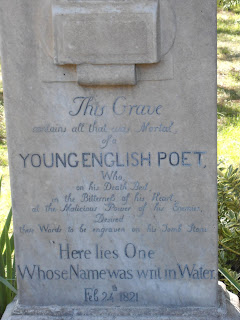12 May
Before I continue, I want to apologize to my professors for the slightly informal tone of this blog, and I apologize to any other readers for the length, because these might get kind of long. I’m trying to write pieces that are thorough and address the assignment while still keeping them kind of engaging.
WELL, NOW THAT THAT’S SAID,
Today we saw/ visited:
- The Pyramid and the Protestant Cemetery where John Keats, Percy Shelley, and numerous other authors and high profile non-Catholics are buried
- The Piazza Spagna
- Sarah, Courtney, and I played Audrey Hepburn, getting gelato and eating it on the Spanish Steps
- We also saw the John Keats and Percy Shelley memorial house, where Keats spent his last days in the companionship and care of his painter friend Joseph Severn
- The Arch of Peace and the Mussolini Square
- The Piazza del Popollo and the Church of Santa Maria del Popollo
- We also did some late-night adventuring around in the Trastevere area.
Piazzas are starting to become like castles were in Scotland; they're everywhere, and you begin to see so many that they all run together in your head.
The John Keats house was particularly interesting, and I wish we could have spent more time there. It was just a few small rooms, but it was moving to look out the window of John Keats' bedroom and imagine him looking out of that same window over the piazza over a hundred years ago, slowly dying of tuberculosis and missing the love of his life, Fanny Brawne, who was back in England. The house contained paintings, manuscripts, letters, etc., focusing on Lord Byron, Mary Shelley, Fanny Brawne, Fanny Keats, and Joseph Severn, among others related to Keats and Shelley. The walls of the small place itself were lined with bookshelves filled with books by writers such as Charles Lamb and Wordsworth.
We also went to the Protestant Cemetery, which is where Keats is buried. This cemetery, although lacking the small mausoleums and sepulchers one sees in the old Catholic cemeteries, was still on a large scale. Many of the tombstones were works of art; Emelyn Story's tomb had a huge, weeping angel over it. The inscription said it was the last work her husband (presumably an artist) did, and he did it in her honor. Chris and I were talking about it. What must he have felt while he was making that piece? Those works take a long time to do. He must have really loved her. Chris and I also did some sleuthing. We found a mausoleum holding the remains of the Andersen family. We were trying to figure out who was what member of the family, and why there was a statue of someone named Olivia in the wall of the mausoleum, even though she was not the first to die.
John Keats thought he was a failure when he died (actually, he thought he would probably be posthumously appreciated, but at the moment he was quite the opposite). So did so many now acclaimed artists, authors, and leaders. When you think about this in a city that has so much history, and has stood the test of time as Rome has, you can't help but think about your place in the scope of human history. We can't label or objectively analyze any movement, event, or person until long after anyone who remembers them are gone. I suppose that it's probably useless to try to analyze ourselves, then. We can’t know the true, long-term scope of our actions in our lifetimes.


